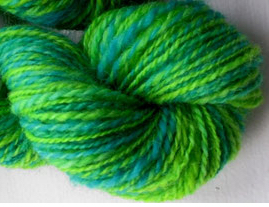Spun up colourways: FRET CFP-YFP
Whenever I dye up a new colorway, I always want to spin up a sample of it, just to see how it looks and give customers some idea of what their final yarn might look like. Sadly, I'm not very good about sitting down and doing the sampling, so it doesn't always work out that way.
When I spin at home, I usually open up a bag and start right in with no sampling whatsoever. Sometimes I've got a project in mind for the final yarn, sometimes not. But I don't usually sample unless I'm trying to reproduce a particular commercial yarn (I've blogged about my sampling experience previously) for a project.
One of the best things about Wool House was the opportunity to try out some of the new colorways and do some sampling. I was there for a couple of hours each time, so a perfect amount of time to play around with spinning styles and plying styles and whatnot. I managed to sample three different colorways - today's example is some glorious, truly brightly colored Romney.
FRET CFP-YFP on Romney
I started with some of this gorgeous stuff. When I dye up a lot of fiber, I do more then needed for a particular number of bags (i.e. 17+ ounces to end up with four 4 oz bags). When the fiber gets split up for packaging, I pull off the slightly matted ends and however much more I need to pull off to get 4 oz bundles. Those leftover bits are then free for me to play with however I like. This time around, I sampled.
The three sample skeins: a 2-ply, a chain ply, and a true 3-ply (i.e. not chain plied).
First up is the 2 ply (left picture). I had three chunks of fibre that were more or less the same size, with more or less the same colour distribution, so I took the first one and split it lengthwise three times, generating four pieces of top that were roughly the same length. I spun two pieces on one bobbin, two pieces on another bobbin and plied them together. I ended up with a bit more yardage on one bobbin, so I wound it off around my hand and Andean plied the rest of the singles, which is my typical solution to uneven single amounts.
I'd spun up a bit of this Romney before, and enjoyed it, but I was really impressed by how soft and silky it spun up in the final yarn. Romney is a long wool, and can be a bit on the coarser side, but this top is truly luscious. The final 2 ply is soft, with a really lovely drape and not a lot of elasticity (as you would expect from the breed).
The next sample I spun was the chain ply (middle picture). I split the fibre the same way and spun them all end to end. Then I plied from that. I've found that, while I need to stop and start when chain plying on my Lendrum, I can just set the speed on the miniSpinner down a bit lower and do the chaining without having to stop entirely. This goes back to my initial observation that I wasn't getting enough twist insertion with the miniSpinner. In this case, not a bad thing!
The chain plying plays up on the colour blending in this colourway - there are distinct solid turquoise and yellow sections, but a lovely green mix at the interfaces that is just what I was hoping for with this colorway. Result!
Last, but not least, the true 3 ply (right picture). For this I split the fiber a bit differently so I could get a fractal three ply. I pulled the length of top I had into 3 pieces of equal length. The first I split into half lengthwise, the second into quarters lengthwise, and the last I left intact. The end result is a yarn that has one ply running from blue to yellow to blue, one ply that goes blue/yellow/blue/blue/yellow/blue, and one that goes blue/yellow/blue/blue/yellow/blue/blue/yellow/blue/blue/yellow/blue. So some stretches are all one color, some are 2 plies color A/1 ply color B, and some sections are 1 ply color A/2 plies color B. I find this a really good technique for blending the colors in a handdyed top to reduce the amount of striping that shows up in the finished piece (particularly for sweaters or other larger projects).
Of course the real test of all this sampling is knitting the swatches. I have good intentions to do so, but I suspect I might need another Wool House to actually sit down and get them done!















